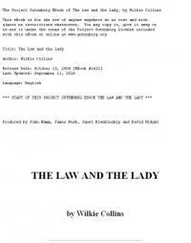Thomas Troward - The Law and the Word
Здесь есть возможность читать онлайн «Thomas Troward - The Law and the Word» — ознакомительный отрывок электронной книги совершенно бесплатно, а после прочтения отрывка купить полную версию. В некоторых случаях можно слушать аудио, скачать через торрент в формате fb2 и присутствует краткое содержание. Жанр: unrecognised, на немецком языке. Описание произведения, (предисловие) а так же отзывы посетителей доступны на портале библиотеки ЛибКат.
- Название:The Law and the Word
- Автор:
- Жанр:
- Год:неизвестен
- ISBN:нет данных
- Рейтинг книги:4 / 5. Голосов: 1
-
Избранное:Добавить в избранное
- Отзывы:
-
Ваша оценка:
- 80
- 1
- 2
- 3
- 4
- 5
The Law and the Word: краткое содержание, описание и аннотация
Предлагаем к чтению аннотацию, описание, краткое содержание или предисловие (зависит от того, что написал сам автор книги «The Law and the Word»). Если вы не нашли необходимую информацию о книге — напишите в комментариях, мы постараемся отыскать её.
Troward was a past president of the International New Thought Alliance
The Law and the Word — читать онлайн ознакомительный отрывок
Ниже представлен текст книги, разбитый по страницам. Система сохранения места последней прочитанной страницы, позволяет с удобством читать онлайн бесплатно книгу «The Law and the Word», без необходимости каждый раз заново искать на чём Вы остановились. Поставьте закладку, и сможете в любой момент перейти на страницу, на которой закончили чтение.
Интервал:
Закладка:
when the music stops is found to settle into definite forms, sometimes
like a tree or a flower, or else some geometrical figure, but never a
confused jumble. Perhaps in this we may find the origin of the legends
regarding the creative power of Orpheus' lyre, and also the sacred
dances of the ancients--who knows!
Perhaps some critical reader may object that sound travels by means of
atmospheric and not etheric waves; but is he prepared to say that it
cannot produce etheric waves also. The very recent discovery of
transatlantic telephoning tends to show that etheric waves can be
generated by sound, for on the 20th of October, 1915, words spoken in
New York were immediately heard in Paris, and could therefore only have
been transmitted through the ether, for sound travels through the
atmosphere only at the rate of about 750 miles an hour, while the speed
of impulses through ether can only be compared to that of light or
186,000 miles in a second. It is therefore a fair inference that etheric
vibrations can be inaugurated by sound.
Perhaps the reader may feel inclined to say with the Irishman that all
this is "as dry as ditch-water," but he will see before long that it has
a good deal to do with ourselves. For the present what I want him to
realize by a few examples is the mathematical accuracy of Law. The value
of these examples lies in their illustration of the fact that the Law
can always be trusted to lead us on to further knowledge. We see it
working under known conditions, and relying on its unchangeableness, we
can then logically infer what it will do under other hypothetical
conditions, and in this way many important discoveries have been made.
For instance it was in this way that Mendeléef, the Russian chemist,
assumed the existence of three then unknown chemical elements, now
called Scandium, Gallium and Germanium. There was a gap in the orderly
sequence of the chemical elements, and relying on the old maxim--"Natura
nihil facit per saltum"--Nature nowhere leaves a gap to jump over--he
argued that if such elements did not exist they ought to, and so he
calculated what these elements ought to be like, giving their atomic
weight, chemical affinities, and the like; and when they were discovered
many years later they were found to answer exactly to his description.
He prophesied, not by guesswork, but by knowledge of the Law; and in
much the same way radium was discovered by Professor and Madame Curie.
In like manner Hertz was led to the discovery of the electro-magnetic
waves. The celebrated mathematician Clerk-Maxwell had calculated all
particulars of these waves twenty-five years before Hertz, on the basis
of these calculations, worked out his discovery. Again, Neptune, the
outermost known planet of our system was discovered by the astronomer
Galle in consequence of calculations made by Leverrier. Certain
variations in the movements of the planets were mathematically
unaccountable except on the hypothesis that some more remote planet
existed. Astronomers had faith in mathematics and the hypothetical
planet was found to be a reality. Instances of this kind might be
multiplied, but as the French say "à quoi bon?" I think these will be
sufficient to convince the reader that the invariable sequence of Law is
a factor to be relied upon, and that by studying its working under known
conditions we may get at least some measure of light on conditions which
are as yet unknown to us.
Let us now pass on to the human subject and consider a few examples of
what is usually called the psychic side of our nature. Walt Whitman was
quite right when he said that we are not all included between our hat
and our boots; we shall find that our modes of consciousness and powers
of action are not entirely restricted to our physical body. The
importance of this line of enquiry lies in the fact that if we do
possess extra-physical powers, these also form part of our personality
and must be included in our estimate of our relation to our environment,
and it is therefore worth our while to consider them.
Some very interesting experiments have been made by De Rochas, an
eminent French scientist, which go to show that under certain magnetic
conditions the sensation of physical touch can be experienced at some
distance from the body. He found that under these conditions the person
experimented on is insensible to the prick of a needle run into his
skin, but if the prick is made about an inch-and-a-half away from the
surface of the skin he feels it. Again at about three inches from this
point he feels the prick of the needle, but is insensible to it in the
space between these two points. Then there comes another interval in
which no sensation is conveyed, but at about three inches still further
away he again feels the sensation, and so on; so that he appears to be
surrounded by successive zones of sensation, the first about an
inch-and-a-half from the body, and the others at intervals of about
three inches each. The number of these zones seems to vary in different
cases, but in some there are as many as six or seven, thus giving a
radius of sensation, extending to more than twenty inches beyond the
body.
Now to explain this we must have recourse to what I have already said
about waves. The heart and the lungs are the two centres of automatic
rhythmic movement in the body, and each projects its own series of
vibrations into the etheric envelope. Those projected by the lungs are
estimated to be three times the length of those projected by the heart,
while those projected by the heart are three times as rapid as those
projected by the lungs. Consequently if the two sets of waves start
together the crest of every third wave of the rapid series of short
waves will coincide with the crest of one of the long waves of the
slower series, while the intermediate short waves will coincide with the
depression of one of the long waves. Now the effect of the crest of one
wave overtaking that of another going in the same direction, is to raise
the two together at that point into a single wave of greater amplitude
or height than the original waves had by themselves; if the reader has
the opportunity of studying the inflowing of waves on the seabeach he
can verify this for himself. Consequently when the more rapid etheric
waves overtake the slower ones they combine to form a larger wave, and
it is at these points that the zones of sensation occur. If the reader
will draw a diagram of two waved lines travelling along the same
horizontal line and so proportioned that the crest of each of the large
waves coincides with the crest of every third wave of the small ones, he
will see what I mean: and if he then recollects that the fall in the
larger waves neutralizes the rise in the smaller ones, and that because
this double series starts from the interior of the body the surface of
the body comes just at one of these neutralized points, he will see why
sensation is neutralized there; and he will also see why the succeeding
zones of sensation are double the distance from each other that the
first one is from the surface of the body; it is simply because the
surface of the body cuts the first long wave exactly in the middle, and
therefore only half that wave occurs outside the body. This is the
explanation given by De Rochas, and it affords another example of that
principle of mathematical sequence of which I have spoken. It would
Читать дальшеИнтервал:
Закладка:
Похожие книги на «The Law and the Word»
Представляем Вашему вниманию похожие книги на «The Law and the Word» списком для выбора. Мы отобрали схожую по названию и смыслу литературу в надежде предоставить читателям больше вариантов отыскать новые, интересные, ещё непрочитанные произведения.
Обсуждение, отзывы о книге «The Law and the Word» и просто собственные мнения читателей. Оставьте ваши комментарии, напишите, что Вы думаете о произведении, его смысле или главных героях. Укажите что конкретно понравилось, а что нет, и почему Вы так считаете.












